Stats guru Bill James recently tweeted about an interesting milestone for the A’s franchise:

That would be 54 years each: Philadelphia (1901-1954) and Oakland (1968-2021).
The interregnum: Kansas City (1955-1967).
The Philadelphia A’s won five World Series. Oakland has won four. The Kansas City A’s never had a winning season.
For all of the 54 years the team was in Philadelphia, Connie Mack was part of the ownership. For the first 50 years, he was also the manager (always dressed in a suit, not a uniform). After the 1954 season, Mack sold the A’s to Arnold Johnson who moved the team to Kansas City. Mack attended the first A’s game in Kansas City on April 12, 1955, and chatted with Harry Truman before the former president threw out the ceremonial first pitch (Truman Library photo below). Mack died the following February at age 93.

After the 1960 season, Charlie Finley bought the A’s from the Arnold Johnson estate. Most Kansas City sports fans have a low opinion of Finley. And why not? He took our major league franchise, just starting to show some promise with the likes of Catfish Hunter and Reggie Jackson, and moved the team to Oakland in 1968. They went on to win the World Series in 1972, 1973 and 1974.
But Charlie did at least one good thing for our city. He promoted the early career of George Toma. And thankfully George did not follow Finley to Oakland.
George Toma and Charlie Finley: Toma moved to Kansas City in 1957 to be the head groundskeeper for the A’s. The field was a mess – more weeds than grass. Toma had only a one-man staff, so he used local high school students to fill out his grounds crew. On a shoestring budget, Toma and his crew turned the field around in only a few weeks. In his words, from his 2004 biography Nitty Gritty Dirt Man, the field went “from an eyesore into an oasis in the desert…It was like playing on a pool table.” Toma especially loved the high school kids:
“I can’t say enough about the inner city kids who worked part time on our crew. This was before the civil rights movement, but black and white kids worked side by side as if they were family…I’ve never had a crew work faster. Mel Allen, the well-known Yankees broadcaster, once used a stopwatch to time how long it took from the time the umpire dropped his hand until the crew covered the field…Forty-five seconds. During the fifth inning, the crew could drag the infield, change the bases and sweep the baselines in 28 seconds.”
I knew that Hot Stove contributor Bill Wakefield had worked for the A’s in 1957, and so I asked him for his memories about Toma. Bill was 16 at the time and worked as an office/errand boy for the team. This included driving Toma out to the Municipal Farm to pick up sod for the field. On rainy days, “George would come up to the office – I would try to hide and look busy – George would find me – and say hey it’s gonna rain – we need you tonight on the tarp crew. OK with me. It wasn’t demanding, close to the action and I fit in.” As for his impression of Toma, “Toma was the best – likeable – told great stories – clearly liked his job and the A’s – and taught me a lot.” Bill was signed by the Cardinals in 1961 and pitched a major league season with the Mets in 1964.
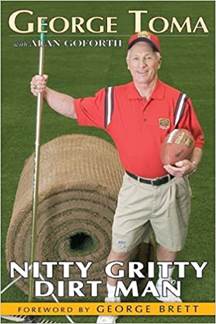
When Finley bought the team in December of 1960, he recognized Toma’s value and immediately doubled his salary. A wise decision. From Toma:
“But you know who helped me more than anyone? Charles O. Finley, one of the most despised owners in the game. I still consider Charlie the finest owner I ever worked for. The first thing he did when he bought the team was double my salary. The town hated Finley, but what I liked about him is that he took care of the little guy. He never lost the common touch.”
Toma appreciated what Charlie did for the kids on the grounds crew. When they quickly got the tarp down for rain, Finley would give the kids a little bonus and also send them down to Arthur Bryant’s Barbeque and have Arthur send him the bill. Late in the season, Finley gave each kid two weeks’ pay to buy school clothes. Also a little cash at Thanksgiving and Christmas.
The appreciation was mutual. In his book, Toma recounts a story that Finley told on many occasions:
“I had a dream last night about Toma. I died and went to heaven, where St. Peter greeted me at the pearly gates. He read my card and said, ‘So you like sports. I’m sure you’ll want to see our sports stadium’…and it was a beautiful place…the field was immaculate, without a blade of grass out of place. In the middle of the field was this little man in a white coat. This guy was running around doing everything in sight, making the grass grow here and cutting it there. I asked St. Peter, ‘Who is the guy in the white coat?’ He looked up, kind of laughed and said, ‘Oh that’s God. He thinks he’s George Toma.’”
Well, Toma is known as the “Godfather of Grass” and the “Sodfather.”
Toma, Finley and the Menagerie: Working for Charlie Finley meant more than just creating an immaculate playing field. Toma and his grounds crew were also in charge of the animals inhabiting the ballpark. A zoo in left field with monkeys, pheasants and rabbits. Sheep on the hill behind the right-field fence. And Charlie O., Charley Finley’s mule.
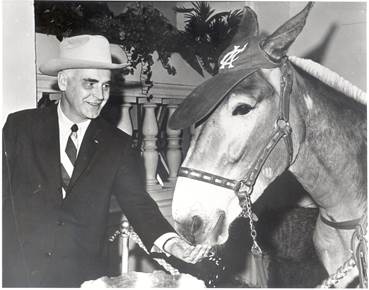
Toma has a couple of stories about the monkeys. Six of the monkeys escaped, and the grounds crew captured four with butterfly nets. The next day, another was found by a lady in her garage. The sixth was never found. Another time, Detroit Tiger players injected vodka in some oranges and fed them to the monkeys. “You haven’t truly experienced life with Charlie Finley until you have contended with drunk monkeys.”
The sheep meadow was known as Lamb Chop Hill, and the man caring for the sheep wore a shepherd’s outfit during the games. One of the duties for the grounds crew was to spray-paint the sheep with different colors. The bonus was that the sheep took care of keeping the grass short on the steep bank.
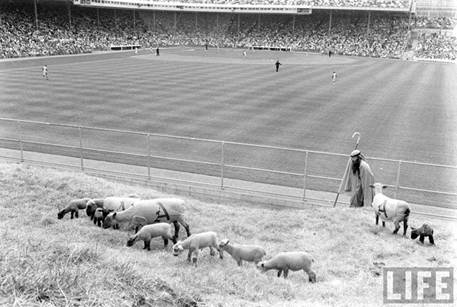
Lamb Chop Hill and a Chipmunk: Charlie’s animal collection did not include any chipmunks, but there was a “Chipmunk” who found himself on Lamb Chop Hill in 1961. He was Stan Isaacs, a sportswriter for Newsday and one of a new breed of young sportswriters who were challenging the old ways at the New York papers. One day in 1962, several of them were in the Yankees locker room chattering away, prompting veteran writer Jimmy Cannon to snarl, “You sound like small, furry animals. You’re making that kind of noise. You sound like a goddamn lot of chipmunks.”
The young writers loved having a name and had it printed on sweatshirts. In a Sporting News article, they were described as having “beatnik tendencies in dress and manner” and “hustle, in the form of endless questioning.” And each Chipmunk had a “constant concern with, and profound admiration for, the literary talents of himself and his fellow chipmunks.” Stan Isaacs said, “When we came along, New York newspapers were stale. They were predictable.” The Chipmunks would change that. The vintage photo below is part of an excellent Grantland article about the Chipmunks.
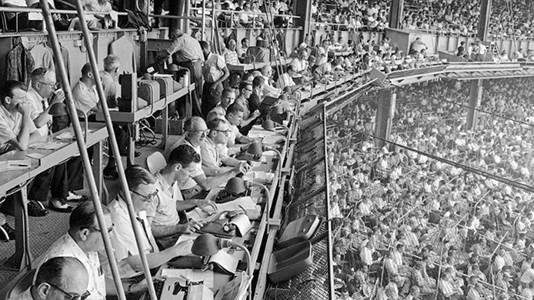
I spotted a familiar name among the Chipmunks. George Vecsey worked at Newsday during his 20s (1960 to 1968) before moving on to a long career at the New York Times. George is a friend of Hot Stove who I met (via email) through Bill Wakefield (as noted above, Bill was once part of Toma’s tarp crew). Vecsey and Wakefield became friends when George covered Bill pitching for the Mets in 1964.
I checked in with Vecsey about the Chipmunks, and he confirmed that “We were proud of it.” Stan Isaacs was a mentor to George at Newsday which had a large sports writing staff. “We thought we were hot stuff…the best sports section in New York, and Stan was our cleanup hitter.” Some forty years later, George wrote the forward to Isaacs’ book, Ten Moments That Shook the Sports World (2008).
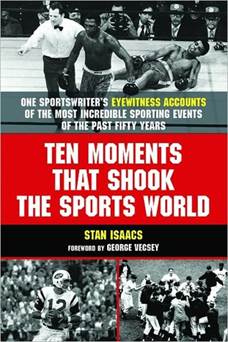
Now back to Lamb Chop Hill. Stan Isaacs was at Municipal Stadium covering the Yankees playing the A’s. He noticed the sheep beyond the right-field wall and had an idea. He picked up his typewriter, left the press box and went to Lamb Chop Hill to report the entire game from that vantage point. Here is how George Vecsey described it in his forward to Isaacs’ book:
“I can still recall the evening in the old Newsday office in Garden City when we learned that Stan was covering the Yankee game in Kansas City – from the sheep pasture in ramshackle Municipal Stadium. This is true. Charles O. Finley, the obstreperous owner of the A’s, while somewhat misanthropic toward his employees, had a fondness for four-legged creatures. Finley had a live mule and an artificial pop-up rabbit that delivered fresh baseballs at home plate, and he also kept a flock of sheep on the steep hill behind the outfield fence…Stan arranged to watch the game from the pasture. He arranged for a mystified Associated Press photographer to transmit a picture of him sitting amidst the sheep. In my memory bank, I seem to recall our caption saying: ‘Stanley, Is That Ewe?’”
When Isaacs wrote his last column in Newsday in 1992, he reminisced about his offbeat coverage of that Yankees-Athletics game. “One of Roger Maris’ 61 homers of that 1961 season landed near me – and a ewe. I gave the ball to Maris afterward. I wish I had kept it.” I checked the log of Maris home runs in 1961 when he topped Babe Ruth. Four were hit at KC’s Municipal Stadium, all likely landing on Lamb Chop Hill since the left-handed Maris was a dead-pull hitter.
Charlie Finley, Lamar Hunt and George Toma: In 1963, Lamar Hunt relocated his Dallas Texans to Kansas City. Finley was not a fan of sharing Municipal Stadium with the newly-branded Chiefs. According to a SABR biography of Toma, Finley paid the remainder of Toma’s 1963 salary on the condition that Toma stay away from Municipal Stadium for the balance of the year. Finley thought this would have the dual advantage of irritating Hunt and perhaps get Toma to stay with the A’s if Finley moved the team. Finley outsmarted himself on this one. He unwittingly opened new doors for Toma.
During his time off, Toma took on turf-related consulting jobs, and one assignment was preparing the Cotton Bowl for the annual NFL Thanksgiving Day game. This led to work on many major football venues, including preparing the field at the Los Angeles Coliseum for the first Super Bowl in January of 1967. That same year was the last season for the A’s in Kansas City, and Finley wanted Toma to go with him. But Toma liked being in Kansas City and had other opportunities for work. He was now working with the Chiefs and had several consulting assignments. Toma’s baseball work in KC had only a one year gap – he became the head groundskeeper for the Royals when they opened their first season in 1969.
Toma continued to work for both the Royals and Chiefs until he retired from full-time work in 1995. He has never stopped doing the Super Bowl – now 54 and counting. Check out this short clip of Toma preparing Hard Rock Stadium earlier this year for Super Bowl LIV. Not only did his hometown Chiefs win the game, but it was on February 2, George’s 91st birthday. I think it’s cool that his birthday is on Groundhog Day, named for one of those burrowing animals that can make life miserable for a groundskeeper.
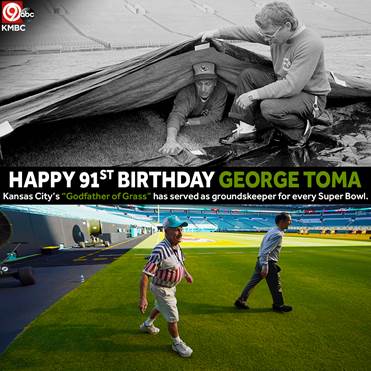
[Burrowing Animal Movie Trivia: Several animals are known to burrow and upset the smoothness of a sports field (groundhogs, gophers, moles, etc.). The most famous groundskeeper plagued with burrowing animals is Bill Murray, the groundskeeper for the golf course in Caddyshack. For the record, those were gophers. But Murray is not groundhog-free. He starred in Groundhog Day, one of my favorite movies.]
If you would like to see some history of Toma’s work on the Super Bowls, check out this 12-minute video.
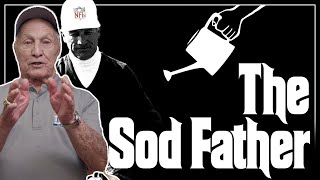
George P. Toma Field: After Toma finished his work at the Super Bowl this year, he headed to Fort Myers for his other break from full-time retirement. For the past 19 years, he has overseen the spring training fields for the Minnesota Twins. This year, his work was cut short when play was suspended because of Covid. But the 91-year-old did not remain idle. He moved his skill-set from pro sports to Wiffle ball.
When Rita and I walk in the area of Loose Park, we see a small baseball field in a side lot of a home at 52nd and Wornall. The field has been there for a few years and is used as a venue for a Wiffle ball league and an annual charity fundraiser. It also serves as a sandlot for random pick-up games by kids in the neighborhood and nearby Visitation school. The big change this year was a special upgrade of the field. By George Toma.
The home belongs to Joe Ungashick who hosts an annual “Wiffle at the Hollow” fundraiser for two charities: C U in the Majors (a Dayton Moore charity) and The Battle Within, a nonprofit organization that supports veterans and first responders who have suffered post-traumatic stress disorder. The event features celebrity teams (many Royals, Chiefs and Sporting players) and a grandstand of spectators. With social distancing necessary this year, the event had to be scaled back to a celebrity home run derby. No grandstand. Masks for the smaller crowd. The fielders you see in the photo below are cutouts of Royals and Monarchs players.
To enhance donor interest in the cause, the organizers called on George Toma – the “Sultan of Sod” – to create a field of dreams. Toma guided a makeshift grounds crew to do the work – members of Toma’s family, a landscape company and a band of neighborhood children and teenagers, much like his recruits in the old days at Municipal Stadium.
From event organizer Joe Ungashick: “Our event had to get creative this year with a Covid-proof approach and George was masterful in turning the field into a baseball-pinball playing field with a paint job worthy of Michelangelo!”
The result: a beautiful field and $120,000 for the charities.

In a ceremony before the home run derby, Toma was surprised when it was announced that the manicured playing surface would be called George P. Toma Field. Below, Toma with his grandson and a cutout of Toma at work on the field. These photos are part of a superb article in The Athletic by Nate Taylor, covering Toma’s career from Municipal Stadium to George P. Toma Field (click here; subscription required).
In Taylor’s article, Toma confirmed that he owed his success to the support he received some sixty years ago at Municipal Stadium. The grounds crew of teenage boys from Central High and Lincoln High. And Finley. “These kids, and Charlie, made George Toma. Without them, I wouldn’t be here.” So glad you are George.
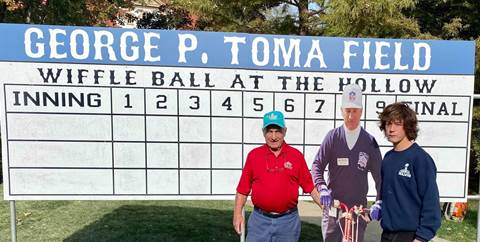
Lonnie’s Jukebox – The Beatles, Charlie Finley and George Toma: In 1964, Charlie Finley made the Beatles an offer they could not refuse. They were paid $150,000 to perform a 31-minute show at Municipal Stadium on September 17, 1964.
But Finley was not happy with the deal that he had signed. To get the Beatles to add Kansas City to the tour, Finley was paying about double what was being paid for other stops. So when the Beatles arrived at the Hotel Muehlebach, they were confronted by Finley who pressed them to sing more than the eleven songs called for in the contract.
As remembered by Larry Kane, a broadcast journalist covering the Beatles on the tour, a defiant John Lennon took Finley on in extended negotiations that led nowhere. And Lennon emphasized what he thought of Finley by calling him “Chuck.” Finley even tried offering more money. Lennon: “No, Chuck. Not enough man. We don’t do it.” Beatles’ manager Brian Epstein pleaded with Lennon to compromise, but John looked at Finley and said “Chuck, no f—king way.”
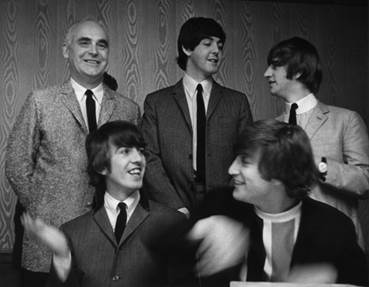
While Finley was busy negotiating with Lennon at the Muehlebach, George Toma was getting the field ready for the band. The stage was set up at second base. The Beatles dressing room was located in Toma’s work area behind the center-field fence. Just before the concert, Finley entered the dressing room to ask one more time for more songs. Lennon would not budge. “Chuck, you shouldn’t have spent so much money on us.” Finley stormed out.
It had been raining, so the field and warning track were wet. The Beatles were to come through the center-field fence entrance and get on an old Budweiser beer truck to get to the stage. Toma’s son Chip put poster board down on the warning track for the guys to walk on. Chip ended up with perfect footprints of all of them, which they autographed after the show. Chip also got Ringo’s drumsticks. Alas, those (priceless) mementos were lost over the years.
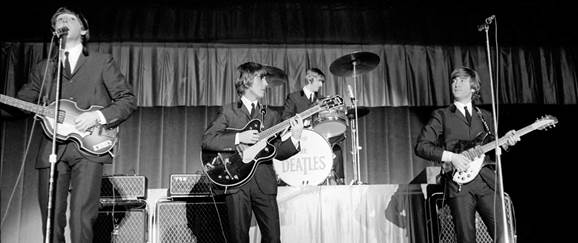
After all that, the Beatles added a song at no charge. How could they not? They were in Kansas City. And in their club gigs, they had been playing a cover of Little Richard’s medley of “Kansas City/Hey-Hey-Hey-Hey.” So they sang the medley to the delight of the crowd. I could find no record of Finley’s response. The Beatles later recorded the song, and fans hear it at Kauffman Stadium at the end of each Royals victory.
Listen to it here: “Kansas City/Hey-Hey-Hey-Hey” by the Beatles.
There was another special person in Municipal Stadium that night. I did not know her then. She was a 14-year-old freshman at St. Teresa’s Academy and attended the concert with her friend Anne Devaney. She still has her ticket stub. The $8.50 tickets were the highest priced that night – on the playing field in front of the stage.

Charlie Finley hoped that the young fans at the concert might also become baseball fans. He delivered that specific message on the back of each ticket, along with a photo showing him being fitted with a Beatles wig.
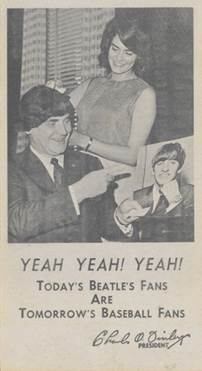
And it came true. Rita Leifhelm, then a screaming 14-year-old at Municipal Stadium, not only became an avid baseball fan, but today she edits a baseball newsletter. This one.
For your listening pleasure, here are two of Rita’s favorite songs from that night in 1964. “I Want To Hold Your Hand” and “Can’t Buy Me Love.”
George Toma was not done with the Beatles – well, one of them. A major part of Toma’s work at the Super Bowls is keeping the field protected when the stage is set up and then dismantled for the halftime entertainment. Not only for the game, but for rehearsals. This has brought him into contact with many stars, and he highlights three of them as being “super nice and approachable”: Paul McCartney, Bruce Springsteen and Lady Gaga. He says Lady Gaga was not surrounded by an entourage and hung out with the grounds crew between practice sessions. He liked that she had not lost her “common touch” (one of the reasons he liked Charlie Finley).
Paul and George (Toma, not Harrison) – 2005 Super Bowl

Lady Gaga and George – 2017 Super Bowl
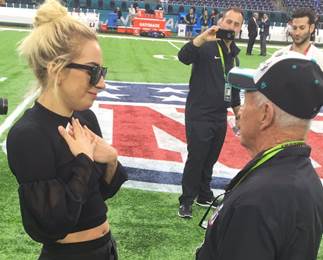
Jukebox selections:
Paul McCartney at the Super Bowl – Click here.
Lady Gaga at the Super Bowl – Click here.
Happy Holidays: Please have a safe holiday season. Rita and I will mostly isolate in our condo, but we do have a nice nighttime view.

Also nice at sunrise this morning.
